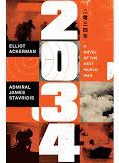 2034 (goodreads.com) 2034: A Novel of the Next World War
by Admiral James Stavridis and Elliot Ackerman
On March 12, 2034, an American Naval flotilla, deep into international waters of the South China Sea encounters "a Chinese ship in distress." The actions of Commodore Sarah Hunt, commanding three guided missile Arleigh Burke class destroyers will into motion World War III.
Just over 300 pages of military strategy and weapons description set in motion two time tracks for action.
The naval series of events provide the foundation for Track No. 1. American Destroyers, Aircraft Carriers Battle fleets, cruise missiles, confront Chinese war ships, planes, cruse missiles, advance naval designed warships, and satellite communications threat from the Chinese war machine.
Action Track No. 2 centers on the weapons platform of an F-35 engaging in hostile mission over Iran.
Both action tracks grab the reader's full attention for detail of weapons and strategies being pitted against the framework of modern geo-political threats and opportunities.
Not since the Tom Clancy book, the Hunt for the Red October, has a futurist military book captured America's attention. Clancy wrote about the threats of super modern weapons and their potential of destroying the world as well as rewriting and defining global superpower structures spheres of dominance.
These same issues are at work in the 2034 book. Stavridis and Ackerman have built a very scary prospect for war and destruction of the superpowers by over reliance upon high tech weapons platforms and systems.
America spends about 800 billion dollars a year in its federal budget to defend itself. At the dawn of this new century, events are mirroring the time period 100 years ago.
World War I era (1918-1920) secured America's military position within the global ranking of world powers. The war in Europe proved the strength of its land base army. The war also set in motion America's curiosity with creating an Air Force power.
Just 10 years earlier, with the American Spanish War, the U.S. Navy was designed and constructed upon the principals of Alfred Thayer Mahan, a new navy of super battleships.
The strategies of Worlds War II cemented the role of aircraft carriers as the replacement for aging concept of power through battleships.
From 1942, with the Battle of Midway, American military trusted the job of "projection force and power" to the modern air carrier task forces.
Now these same aging air power systems are being challenge by radical new naval tactics and weapons. The two hottest areas for America are (1) the South China Sea and the Battlefields of the Middle East.
Mahan, a lecturer and President of the US Naval War College, published his book on seapower in 1890. Mahan uses his experience and lecture notes to define a new understanding for the power and warfare of modern navies to control geography and trade.
Mahan's thinking on the 1890's geo-political world powers navies still has important relevance in 2021.
A good note on the impact of Mahan is taken from Wikipedia:
"Mahan began the book with an examination of what factors led to a supremacy of the seas, especially how Great Britain was able to rise to its near dominance. He identified such features as geography, population, and government, and expanded the definition of sea power as comprising a strong navy and commercial fleet. Mahan also promoted the belief that any army would succumb to a strong naval blockade.[9]
he Influence of Sea Power Upon History: 1660-1783 is a history of naval warfare published in 1890 by Alfred Thayer Mahan. It details the role of sea power during the seventeenth and eighteenth centuries, and discussed the various factors needed to support and achieve sea power, with emphasis on having the largest and most powerful fleet.
Scholars considered it the single most influential book in naval strategy. Its policies were quickly adopted by most major navies,[3][4][5][6] ultimately leading to the World War I naval arms race. It is also cited as one of the contributing factors of the United States becoming a great power."
Authors Ackerman and Stravridis, in their techno naval thriller, "2034: A Novel of the Next World War" manage to come full circle to Alfred Thayer Mahan's global perspective of using great power to confront great power.
In this new rendering of a possible series of events ripped from the pages of current newspapers, there is no good outcome for humanity. Just as Mahan is required reading for future naval officers, so too will 2034.
In its 303 pages of warfare going very wrong, it aims a direct shot across the bow of military thinkers to consider just how easy it is, and will be, to lose control once the first shot is fired.
The book offers good news in its role of forewarning those who practice the art of war that it is so very easy to make war obsolete when everything is destroyed. |







